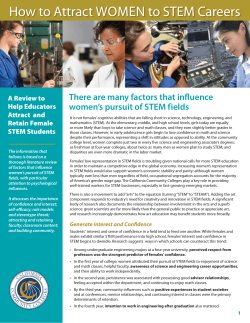
Stem cells in genitourinary regeneration EDITORIAL Open Access John D Jackson
Jackson Stem Cell Research & Therapy 2014, 5:120 http://stemcellres.com/content/5/5/120 EDITORIAL Open Access Stem cells in genitourinary regeneration John D Jackson See related reviews by Eirin and Lerman, http://stemcellres.com/content/5/4/83; Qin et al., http://stemcellres.com/content/5/3/69; Dunlop et al., http://stemcellres.com/content/5/4/98; and Sadri-Ardekani and Atala, http://stemcellres.com/content/5/3/68 The demand for treatment options for the genitourinary tract is ever increasing. Disease, congenital malformations, and injury all lead to decreased function of the organs that make up the genitourinary system. Transplantation has been used successfully to replace failed organs. However, as a result of the limited number of transplantable organs and other complications associated with transplantation, regenerative medicine in conjunction with transplantation may be a future alternative [1]. The use of stem cells in the context of regenerative medicine therapies also opens additional treatment options. In light of these issues, Stem Cell Research & Therapy solicited reviews that focused on the use of stem cells for regeneration of four organs within the genitourinary system. Eirin and Lerman [2] examine the use of mesenchymal stem cells in the treatment of chronic kidney disease. Qin, Long, Deng, and Zhang [3] describe the isolation, characterization, and potential use of urinederived stem cells in the regeneration of bladder. As single cell therapy modalities or combined with biomaterials in tissue engineering strategies, stem cells will play an important role in regeneration of the urinary system in patients with diseased or injured organs. The other two reviews cover the exciting area of germline stem cells and their use in regeneration of ovaries and testes. Dunlop, Telfer, and Anderson [4] detail the characterization of adult ovary germline stem cells. Sadri-Ardekani and Atala [5] review the identification and expansion of spermatogonial stem cells. Both groups discuss the potential clinical application for these germline stem cells. As these technologies develop, they will be critical in the preservation of fertility in patients undergoing treatments that reduce or eliminate fertility. We hope that this series of review articles will stimulate interest in stem cell-induced regeneration of the genitourinary system. Stem Cell Research & Therapy is an excellent forum for the exchange of ideas and information. We encourage our readers to participate by contributing their thoughts and views in this active research area. Note: This article is part of a thematic series on Stem cells in genitourinary regeneration edited by John Jackson. Other articles in the series can be found online at http://stemcellres.com/ series/genitourinary. Competing interests The author declares that he has no competing interests. Received: 23 May 2014 Accepted: 22 October 2014 Published: 27 Oct 2014 References 1. Orlando G, Soker S, Stratta RJ, Atala A: Will regenerative medicine replace transplantation? Cold Spring Harb Perspect Med 2013, 3:a015693. 2. Eirin A, Lerman LO: Mesenchymal stem cell treatment for chronic renal failure. Stem Cell Res Ther 2014, 5:83. 3. Qin D, Long T, Deng J, Zhang Y: Urine-derived stem cells for potential use in bladder repair. Stem Cell Res Ther 2014, 5:69. 4. Dunlop CE, Telfer EE, Anderson RA: Ovarian germline stem cells. Stem Cell Res Ther 2014, 5:98. 5. Sadri-Ardekani H, Atala A: Testicular tissue cryopreservation and spermatogonial stem cell transplantation to restore fertility: from bench to bedside. Stem Cell Res Ther 2014, 5:68. 10.1186/scrt510 Cite this article as: Jackson: Stem cells in genitourinary regeneration. Stem Cell Research & Therapy 2014, 5:120 Correspondence: jojackso@wakehealth.edu Wake Forest Institute for Regenerative Medicine, Wake Forest School of Medicine, Medical Center Boulevard, Winston-Salem, NC 27157, USA © 2014 Jackson; licensee BioMed Central Ltd. This is an Open Access article distributed under the terms of the Creative Commons Attribution License (http://creativecommons.org/licenses/by/4.0), which permits unrestricted use, distribution, and reproduction in any medium, provided the original work is properly credited. The Creative Commons Public Domain Dedication waiver (http://creativecommons.org/publicdomain/zero/1.0/) applies to the data made available in this article, unless otherwise stated.
© Copyright 2025





















